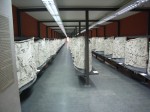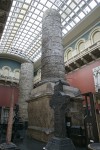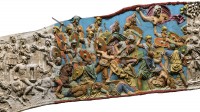 National Geographic has devised some sort of doomsday mind reading device only instead of using it to enslave humanity like the rest of us would, they’ve chosen to hone in on one of my fondest dreams and make it come true: a proper close look at the helical relief that wraps itself around Trajan’s Column. Trajan’s Column, built in 113 A.D. to commemorate the emperor’s victories over the Dacians in two wars (101–102 and 105–106 A.D.), has a 625 foot-long frieze that winds around the 98 foot-high column shaft 23 times. There are 2,662 figures in 155 scenes plus scads of structures (pontoon bridges! forts!) and gear (weapons! army standards! exotic Dacian fashions!). The complexity of the carving, the density of characters and scenes, and, last but certainly not least, the monumental scale of the column make it an ideal candidate for digital exploration. Short of a surreptitious and illegal nighttime visit to Trajan’s Forum aboard a cherry picker, it’s simply impossible to see anything more than the pedestal close up in person.
National Geographic has devised some sort of doomsday mind reading device only instead of using it to enslave humanity like the rest of us would, they’ve chosen to hone in on one of my fondest dreams and make it come true: a proper close look at the helical relief that wraps itself around Trajan’s Column. Trajan’s Column, built in 113 A.D. to commemorate the emperor’s victories over the Dacians in two wars (101–102 and 105–106 A.D.), has a 625 foot-long frieze that winds around the 98 foot-high column shaft 23 times. There are 2,662 figures in 155 scenes plus scads of structures (pontoon bridges! forts!) and gear (weapons! army standards! exotic Dacian fashions!). The complexity of the carving, the density of characters and scenes, and, last but certainly not least, the monumental scale of the column make it an ideal candidate for digital exploration. Short of a surreptitious and illegal nighttime visit to Trajan’s Forum aboard a cherry picker, it’s simply impossible to see anything more than the pedestal close up in person.
 Your best shot at a thorough look at the frieze in person is on the plaster casts in museums. The Museum of Roman Civilisation in the EUR neighborhood of Rome has a blessedly handy collection of casts of the relief separated into sections that are lined up in narrative order along three rows that you can walk through. Because the casts were made in the 19th century, the relief is in better condition than on the original column that has been exposed to an additional century and a half of pollution and erosion. The Victoria & Albert has plaster casts mounted on two central brick columns that makes them look like the column was cut in half. You can view it from ground level or from a gallery.
Your best shot at a thorough look at the frieze in person is on the plaster casts in museums. The Museum of Roman Civilisation in the EUR neighborhood of Rome has a blessedly handy collection of casts of the relief separated into sections that are lined up in narrative order along three rows that you can walk through. Because the casts were made in the 19th century, the relief is in better condition than on the original column that has been exposed to an additional century and a half of pollution and erosion. The Victoria & Albert has plaster casts mounted on two central brick columns that makes them look like the column was cut in half. You can view it from ground level or from a gallery.
 As far as digital options go, there are several excellent sites dedicated to Trajan’s Column. The University of St. Andrews has a phenomenal Trajan’s Column site that has a searchable database of images of the frieze that you can easily click through using a numbered map (after you click on a piece of the frieze, click zoom out to see all the images of that scene). It also has exceptional background information: explanations of numbering conventions used to identify scenes and figures, the drawings and casts that scholars have made to study the column, a detailed description of the column’s history, materials, construction method and more. The only problem is the photographs are small and it’s easy to lose your way in the details. There is no big picture view of the entire relief.
As far as digital options go, there are several excellent sites dedicated to Trajan’s Column. The University of St. Andrews has a phenomenal Trajan’s Column site that has a searchable database of images of the frieze that you can easily click through using a numbered map (after you click on a piece of the frieze, click zoom out to see all the images of that scene). It also has exceptional background information: explanations of numbering conventions used to identify scenes and figures, the drawings and casts that scholars have made to study the column, a detailed description of the column’s history, materials, construction method and more. The only problem is the photographs are small and it’s easy to lose your way in the details. There is no big picture view of the entire relief.
The German Archaeological Institute’s Arachne database has many images of Trajan’s Column, but they’re in black and white, watermarked and the interface is awkward, to put it mildly. Far more user friendly but still information-rich is the Trajan’s Column website created by Dartmouth College professor Roger B. Ulrich. The photographs are too small to quench my thirst. Google Art Project has a handful of good images of the plaster casts at the Museum of Roman Civilisation (this one of Trajan’s cavalry defeating the Sarmatian cataphract heavy cavalry is my favorite because you get to see the weird fish scale armour in detail), but nowhere near enough.
Wikipedia user MatthiasKabel has probably the best photographs of the complete column in situ on the web. Massive panoramas capture each side in exquisitely high resolution. They’re beautiful, but they’re just images, no information or key to help you interpret the riot of people, equipment and action. See them at the bottom of the Trajan’s Column entry.
 The detailed view of the scenes flowing from one to the other has heretofore been lacking. That’s the gap National Geographic has filled. Their interactive graphic has a brief slideshow of highlights you can click through, but most importantly allows you to wind your way around the entire column, zooming in to examine whatever detail catches your fancy. They’ve created a simple color-coded notation system that categorizes the scenes by subject (marches, speeches, construction, etc.) and makes Trajan easy to spot because he’s been tinted yellow in all 58 of the scenes in which he appears.
The detailed view of the scenes flowing from one to the other has heretofore been lacking. That’s the gap National Geographic has filled. Their interactive graphic has a brief slideshow of highlights you can click through, but most importantly allows you to wind your way around the entire column, zooming in to examine whatever detail catches your fancy. They’ve created a simple color-coded notation system that categorizes the scenes by subject (marches, speeches, construction, etc.) and makes Trajan easy to spot because he’s been tinted yellow in all 58 of the scenes in which he appears.
As if that weren’t cool enough, National Geographic raised the bar to infinity and beyond by making a stop-motion animated video of how the column may have been constructed. There are several competing theories on the question, but none of their advocates have made a stop-motion video of them, so, you know…
But wait, there’s more! Damn that video was awesome, you say to yourself. I wish I could see how they made the magic happen. Well your wish has already come true, because there’s a making-of video. :boogie:
Lastly, because they’re a legitimate magazine with articles and what not, National Geographic has a story accompanying the great graphics that gives an overview of the history behind the column and of the Dacian culture Trajan all but obliterated from a perspective that is not imbued with Roman propaganda.